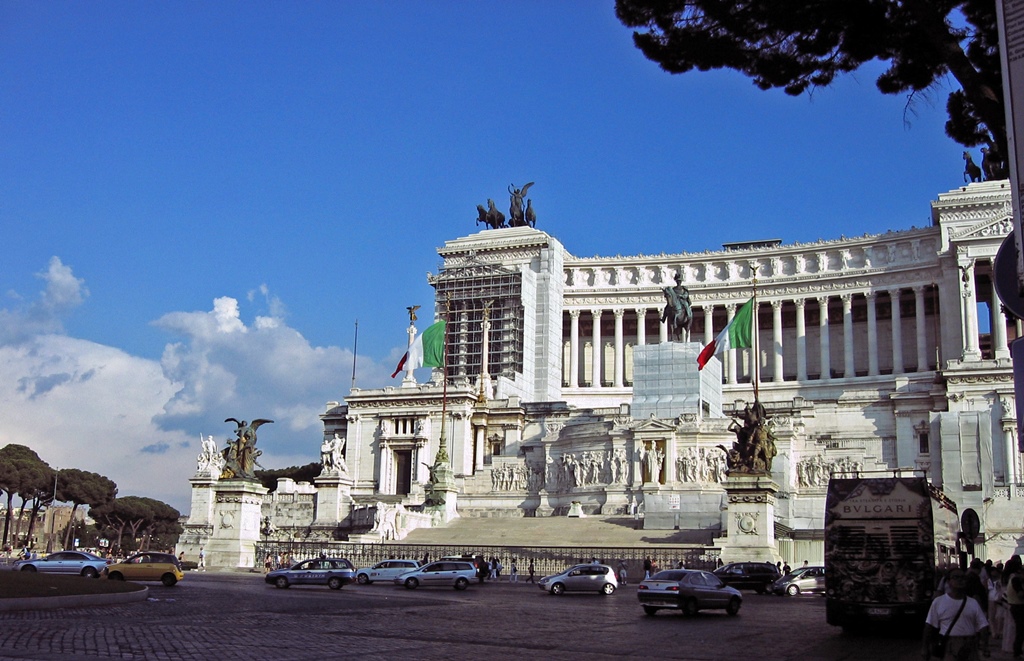Map of Forum Area
For centuries, the main Forum was the political center of Rome. It's located in a
once-swampy lowland area adjoining the Palatine and Capitoline Hills. This area held a
somewhat randomly-arranged assortment of political and religious structures and monuments,
nearly all of which are now in ruins. Many of the structures were destroyed (either
deliberately or accidentally) and rebuilt more than once, and many were partly or
completely buried over the centuries by debris discarded by the citizenry or eroded from
the nearby hills. Excavation of the area to unearth the ruins wasn't begun until the 19th
Century, and much is still buried.
We began our exploration of the Forum from its east end, near the Colosseum. The entrance
was just up Via di San Gregorio from the Colosseum, where there was a fairly short line to
wait in. The first ruins seen, also visible from the Colosseum area, were those of the
Temple of Venus and Rome, which was first built from 121-141 A.D. This was the largest
temple in ancient Rome, architected by the emperor Hadrian. An immense statue of Nero had
to be moved closer to the Colosseum to make room for it. The focus of the temple was two
centrally-located chambers containing seated statues of Venus (goddess of love) and
Roma Aeterna (a goddess personifying the city itself). Apollodorus of Damascus,
Hadrian's chief architect on other projects, thought that Hadrian had made the niches
containing the statues too small, and joked that the statues would "bump their heads" if
they stood up. Hadrian responded with customary Imperial good humor by having Apollodorus
banished and eventually executed. The temple also originally had a forest of columns and
a nave with vaulted ceiling. Earthquakes, erosion and scavenging have taken a toll on the
temple, and all that remains are parts of the chambers (minus the statues) and a number of
columns.

Temple of Venus and Rome

Temple of Venus and Rome
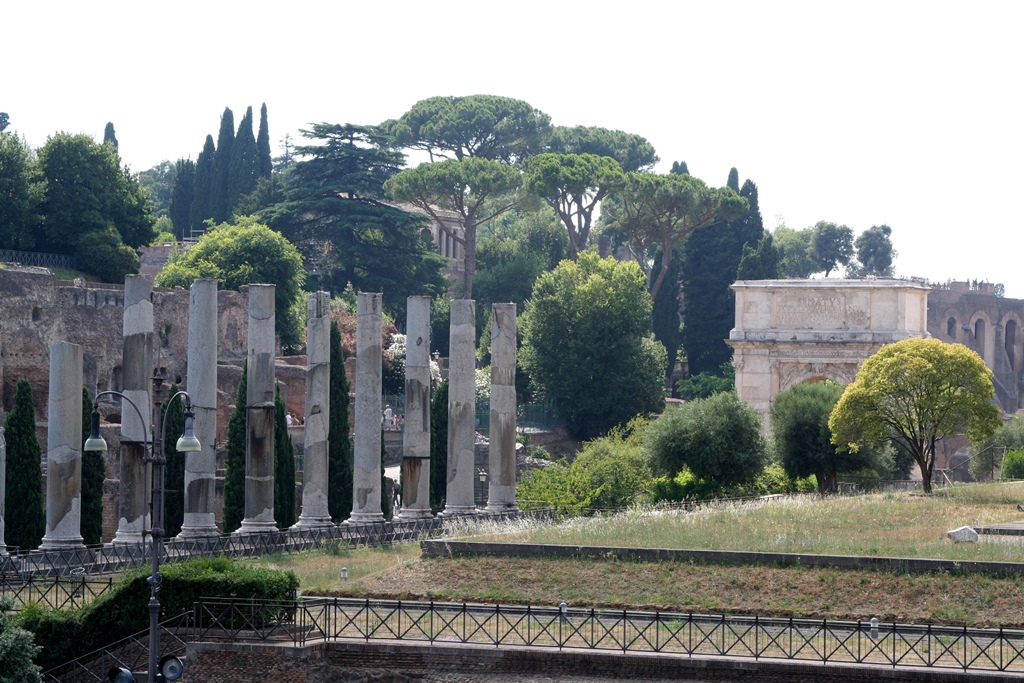
Columns, Temple of Venus and Rome

Columns, Temple of Venus and Rome
Continuing westward past the Temple of Venus and Rome, we came upon the Arch of Titus. This
arch was built around 82 A.D., but not by Titus. It was built by his brother, Domitian, to
honor his recently-deceased brother. A relief inside the arch depicts the sacking of
Jerusalem, which occurred in 70 A.D. During the Middle Ages, the arch was turned into a
fortified tower, at which time any decorations that may have been on the sides of the arch
would have been lost. The arch was significantly damaged by the 19th Century, at which time
it underwent extensive restoration, making it one of the first Roman ruins to receive this
treatment. The arch has served as a model for a number of more modern arches, such as the
Arc de Triomphe in Paris and the Washington Square arch in New York City.
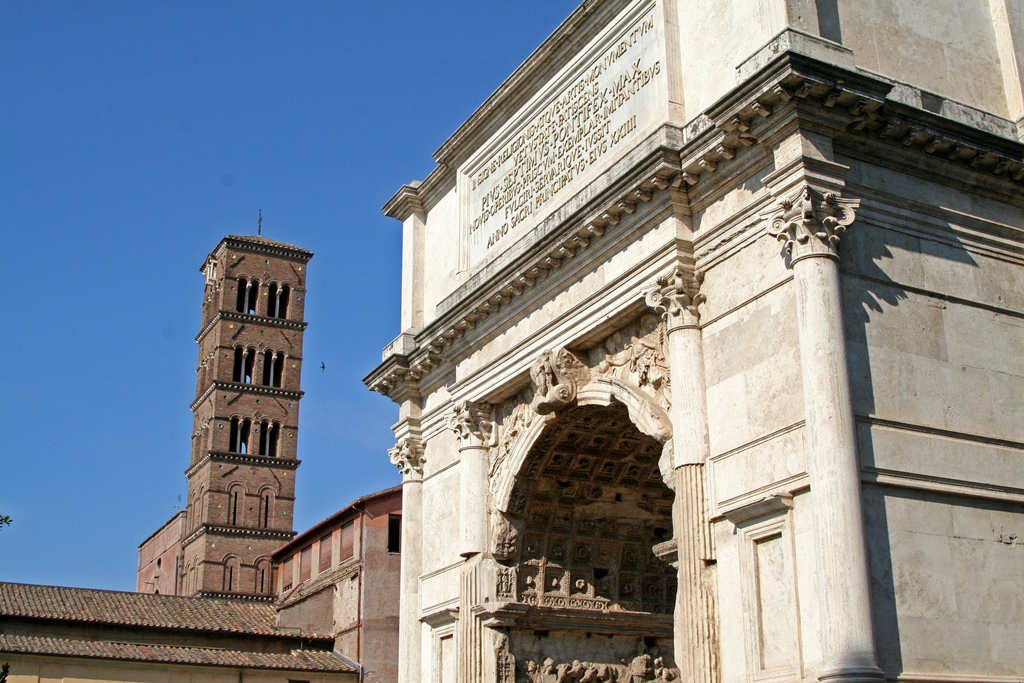
Arch of Titus

Arch of Titus
South of the Arch of Titus we could see the Palatine Hill, which was included in the
combo ticket, but which we did not have time (or energy) to visit. To the north were the
three surviving immense chambers of the Basilica of Maxentius and Constantine, which was
built between 308 and 312 A.D. and was used for purely administrative and political
purposes in ancient Rome.
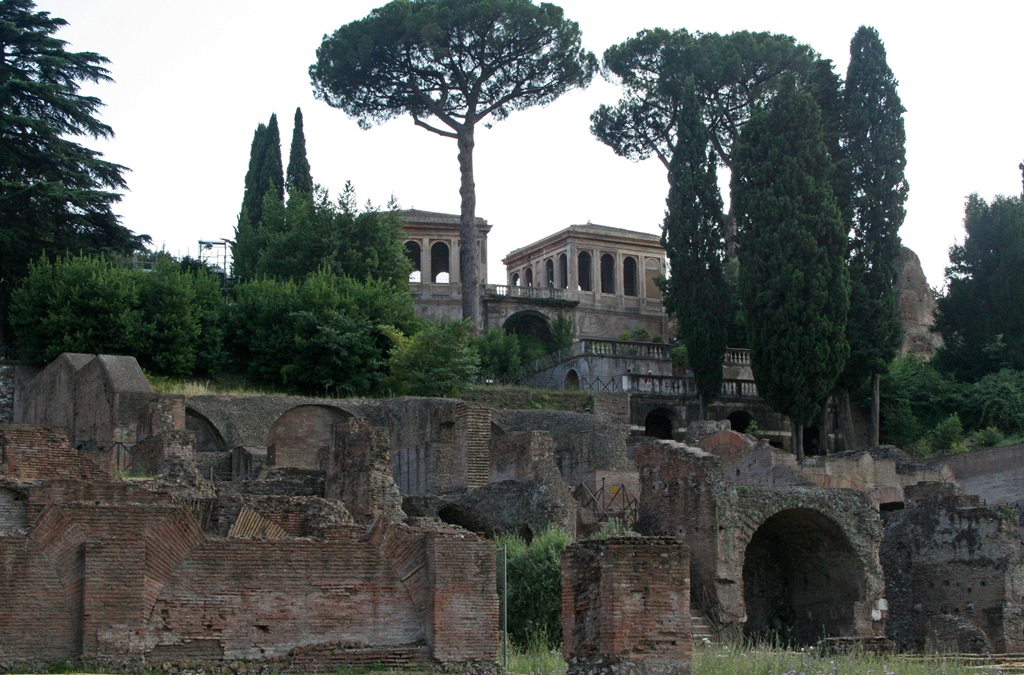
Palatine Hill

Forum, Palatine Hill and Basilica
Basilica of Maxentius and Constantine
At this point the path into the Forum proper began to descend, and we found a smallish
circular structure to our right called the Temple of Romulus. This temple was originally
built by the emperor Maxentius to honor his son, Valerius Romulus, who died in 309 A.D.
Since then it has been incorporated into the structure of a Christian church, the
Basilica of Santi Cosma e Damiano.

Descending, Palatine Hill, Ruins
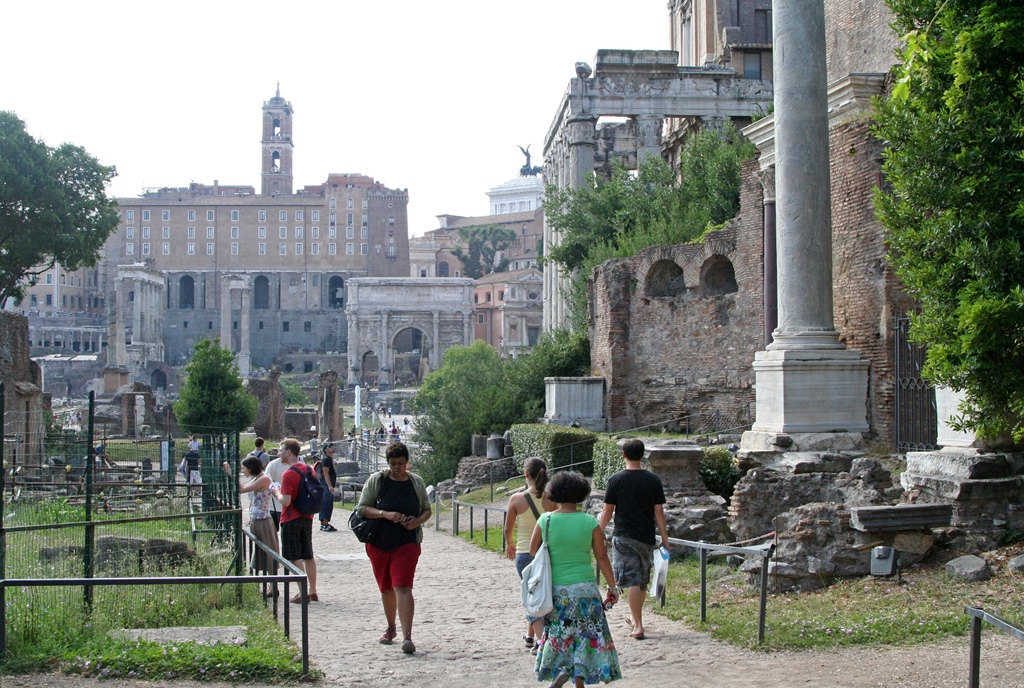
Descending Toward Forum

Temple of Romulus

Temple of Romulus, Temple of Antoninus & Faustina
An even more striking combination of pagan and Christian architecture stands next to
the Temple of Romulus, this being the Temple of Antoninus and Faustina. The temple
was begun in 141 A.D. by the emperor Antoninus to honor his deceased wife, Faustina,
whom he'd deified. After Antoninus died, the dedication was extended to him as well.
At some point, possibly the seventh Century A.D., a Christian church appeared inside
the temple, the church of San Lorenzo in Miranda. The church was remodeled in the
Baroque era, at which time it acquired its present façade. The steps leading up to
the church do not quite reach – the real entrance is at the other end.
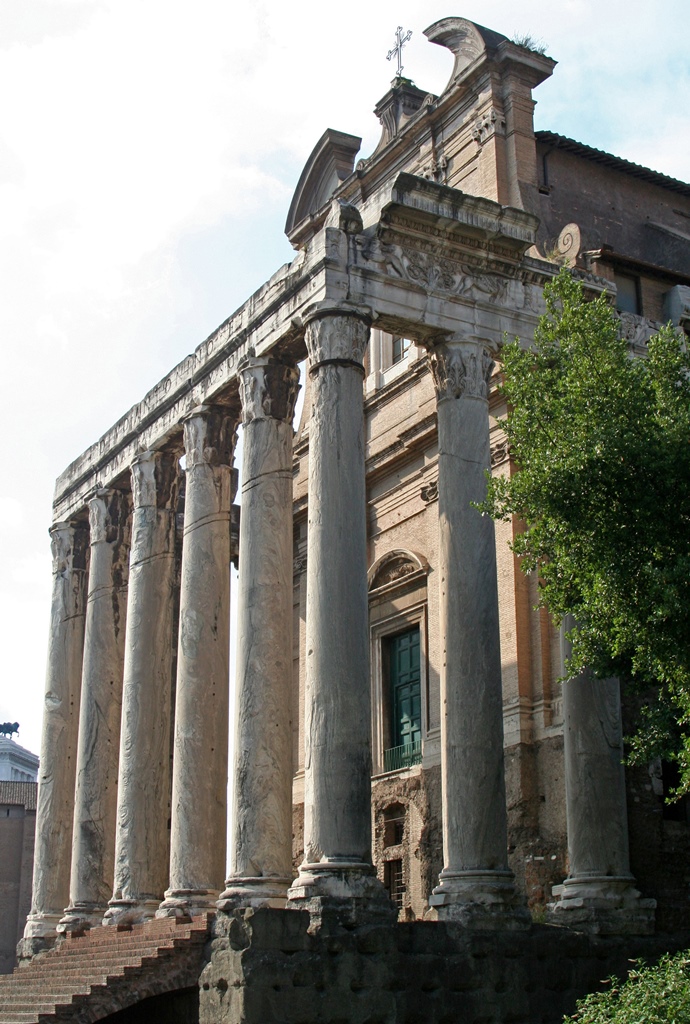
Temple of Antoninus and Faustina
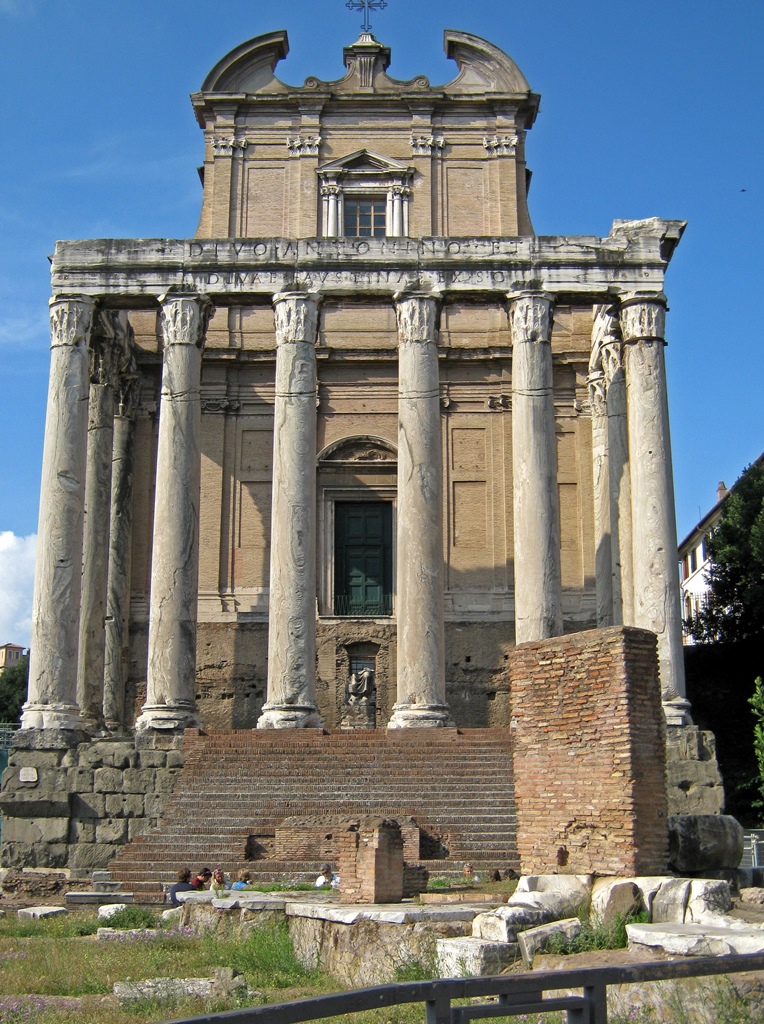
Temple of Antoninus and Faustina
At this point we found ourselves surrounded by ruins in all directions. To the left of
the Temple of Antoninus and Faustina were partly-reconstructed ruins of the Basilica
Aemilia, a building which originally dated back to 179 B.C., with frequent subsequent
updates by the Aemilian family. Just to the south of this area are the ruins of the
Temple of Caesar. This temple was built on the spot where Julius Caesar was cremated
following his assassination on the Ides of March in 44 B.C. Caesar was the first Roman
citizen to be deified in this way. There is a metal roof over the mostly-unrecognizable
remains of the temple's altar to protect it from the elements. People have left flowers,
maybe in case Caesar really was a god.
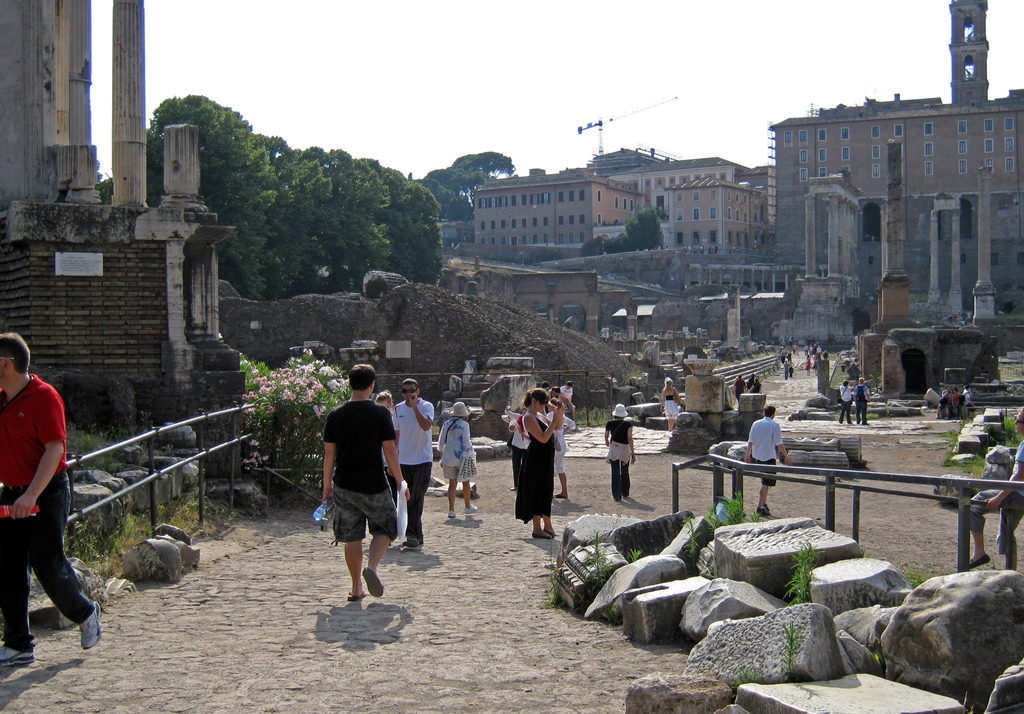
Philip Entering Forum
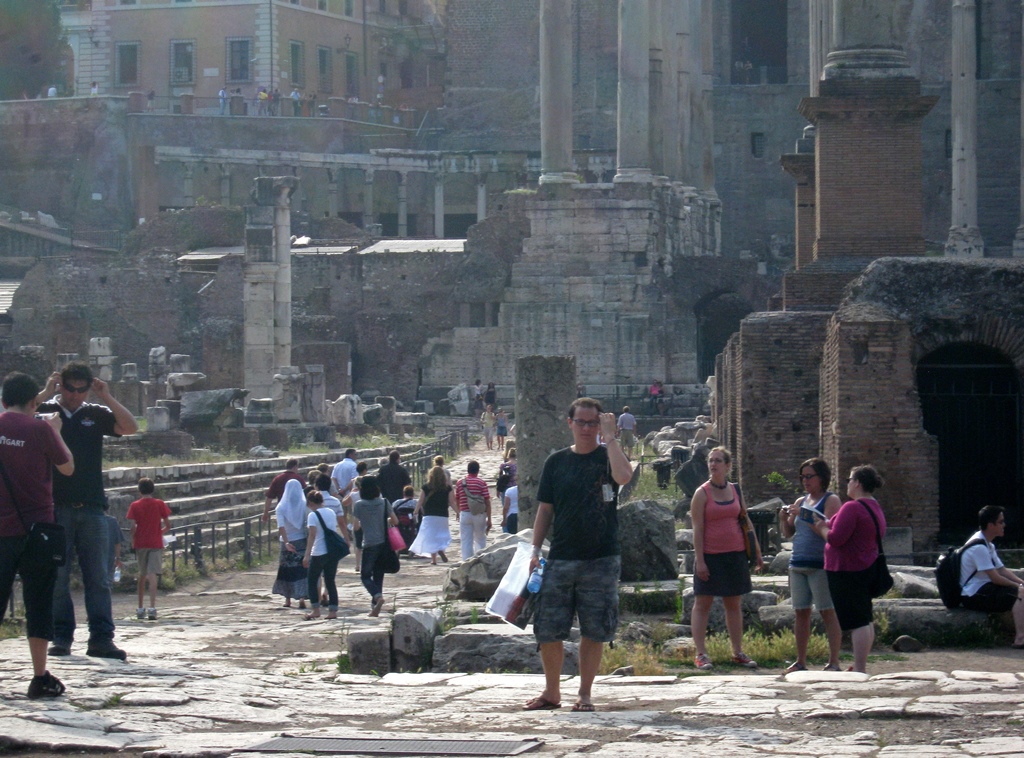
Philip in Forum
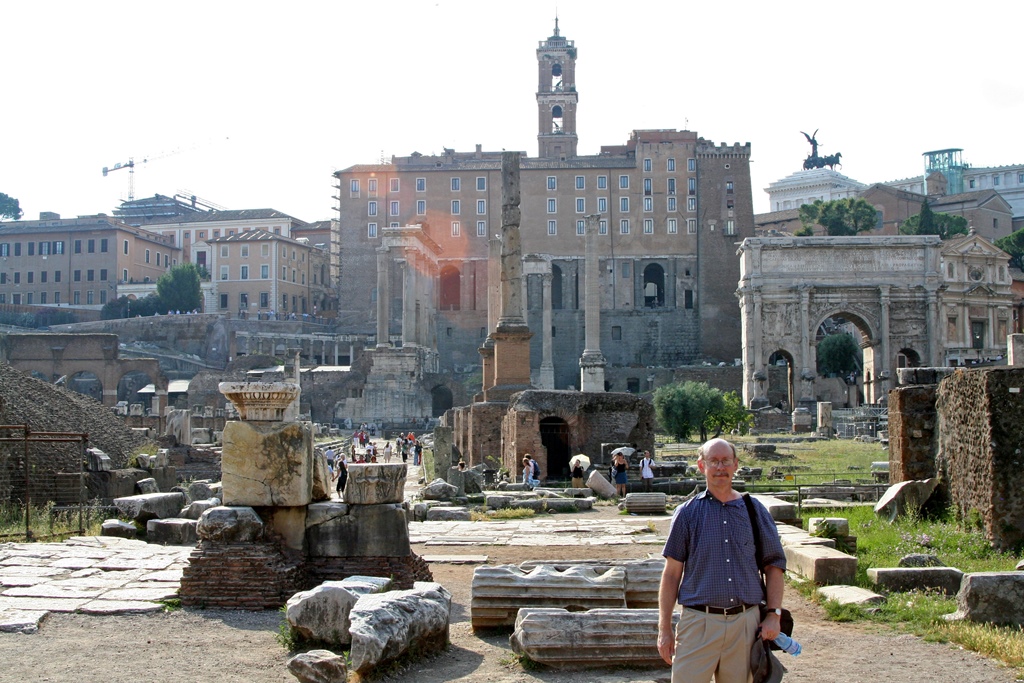
Bob in Forum
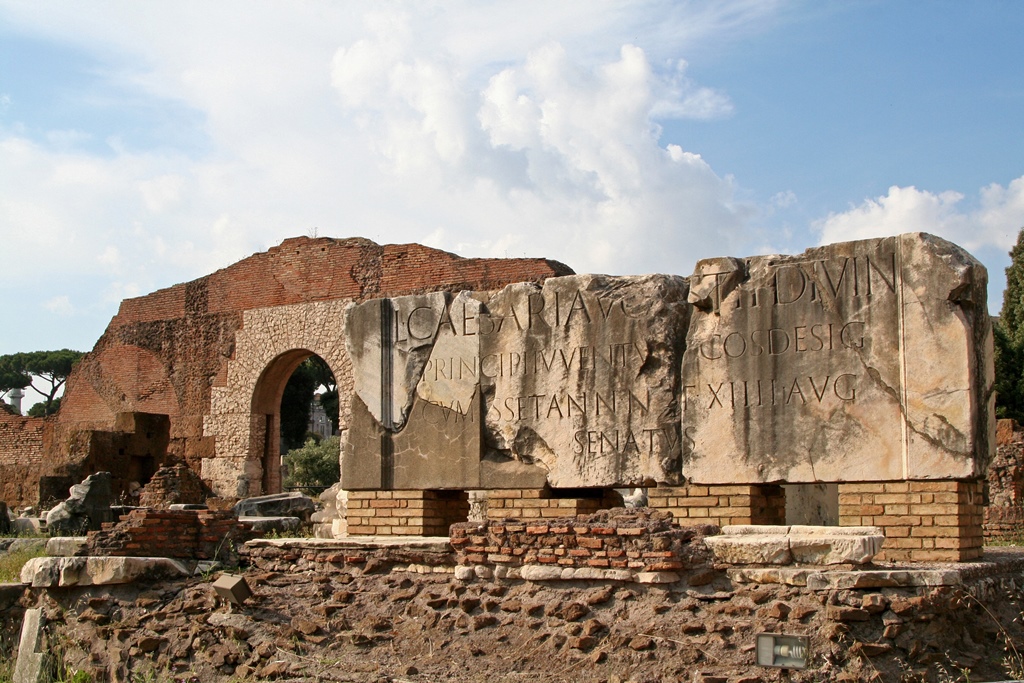
Basilica Aemilia

Basilica Aemilia, Temple of Antoninus & Faustina
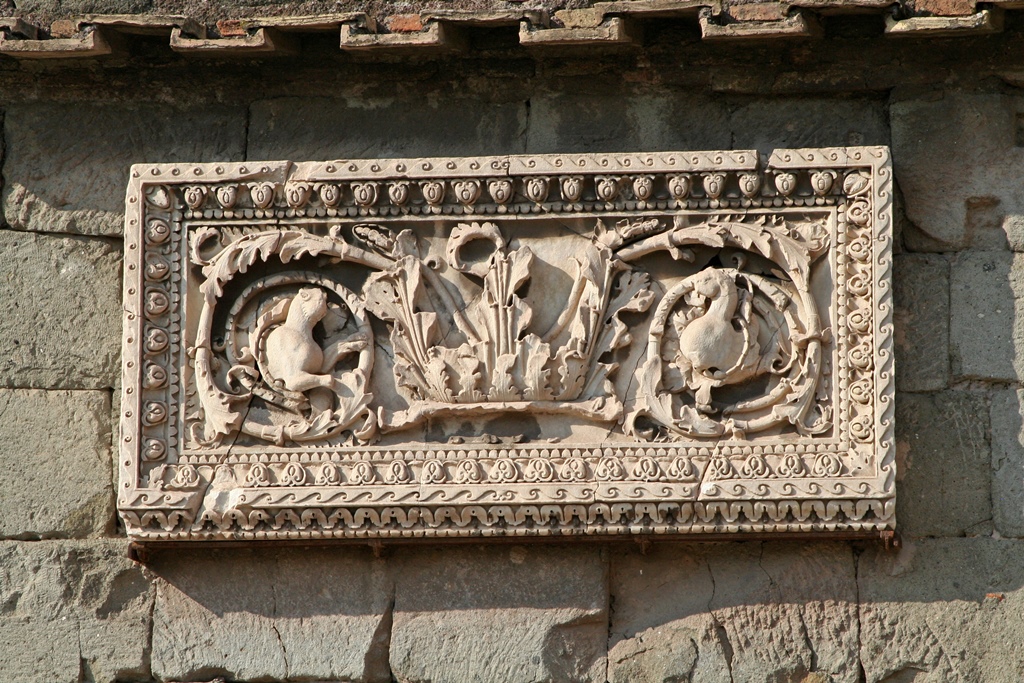
Relief, Basilica Aemilia
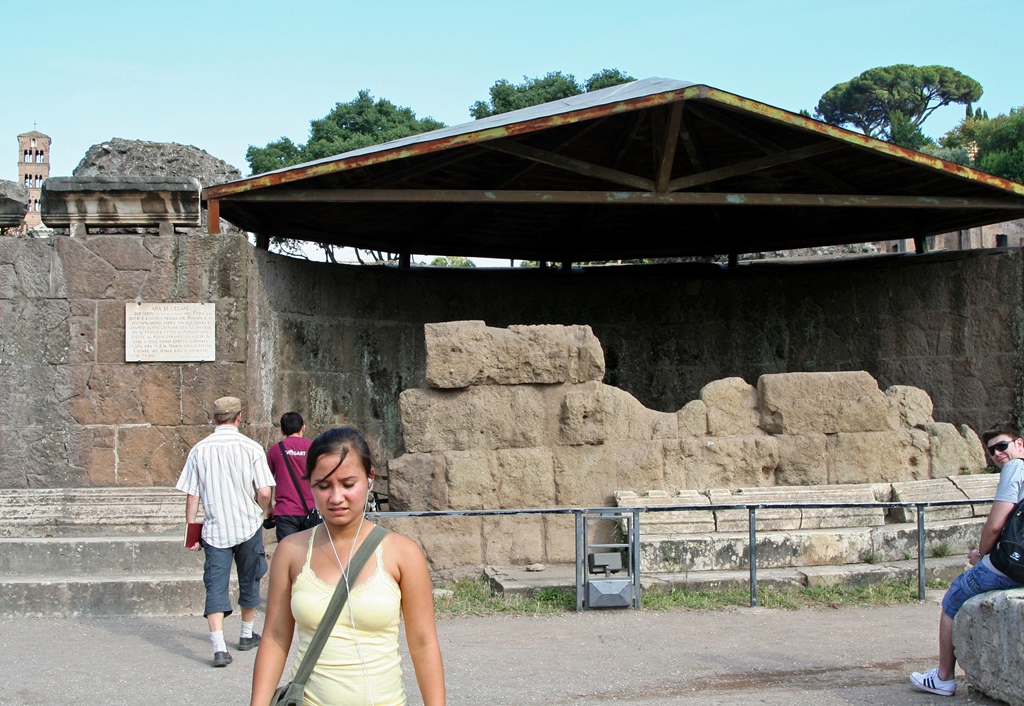
Connie and Temple of Caesar

Temple of Caesar and Surroundings

Nella Emerging from Temple of Caesar
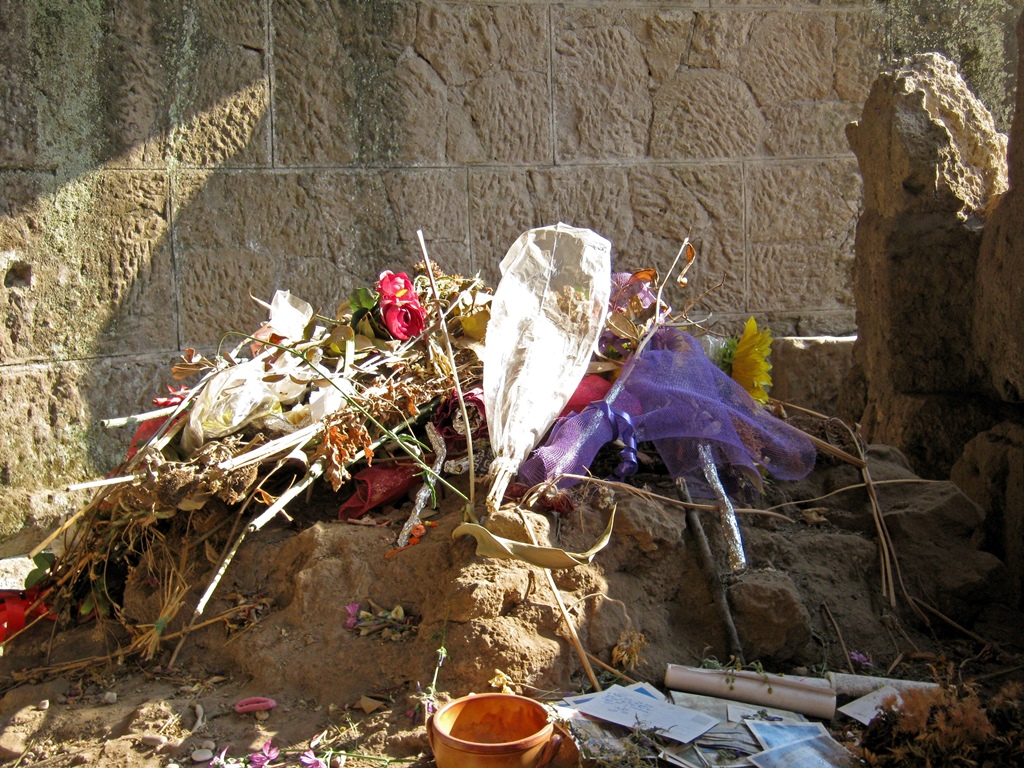
Flowers on Remnants of Altar, Temple of Caesar
Further south is the partly-reconstructed Temple of Vesta and the House of the Vestal
Virgins. The Temple was round in shape, as seen in the reconstructed fragment, and
housed a sacred flame which was tended by the Vestal Virgins, who lived in a large,
luxurious house next door. Besides keeping the fire going, they also had the
responsibilities of tending to a number of sacred objects, plus the wills and
testaments of some of the aristocracy. And they had to remain virgins for 30 years.
They enjoyed a number of privileges not available to ordinary Roman citizens, such as
prime reserved seating at performances and contests and the ability to pardon
condemned prisoners. But if they were found to be less than virginal, they were
buried alive in an underground chamber, and their lovers were publicly flogged to
death.

Temple of Vesta

House of the Vestal Virgins
To the west of the Temple of Vesta are the three surviving columns of the Temple of
Castor and Pollux (the "Gemini Twins"). This temple was built and rebuilt a number of
times, and the remaining fragment dates back to 6 A.D. At various times the temple
served as a meeting place for the Roman Senate, as the office of weights and measures,
and as a depository for the state treasury.

Temple of Castor and Pollux

Temple of Castor & Pollux, Temple of Vesta
Back on the north side of the Forum, next to the Basilica Aemilia ruins, is a large,
brick-covered building that is largely intact, and therefore not obviously ancient. This
is the Curia Julia, which dates back to 283 A.D., at which time it was rebuilt by
Diocletian (construction of the original building was begun by Julius Caesar in 44 B.C.).
It was completely restored by Mussolini in 1937-38. The cavernous building was used as a
meeting place for the Roman Senate, and was capable of seating 465 people, if benches
were used. On display in the building are two relief panels, originally used as
decoration for the Rostra, or speaking platform, near the Curia. The panels
depict altruistic acts by the emperor Trajan.

Bob, Connie, Philip and Curia Julia
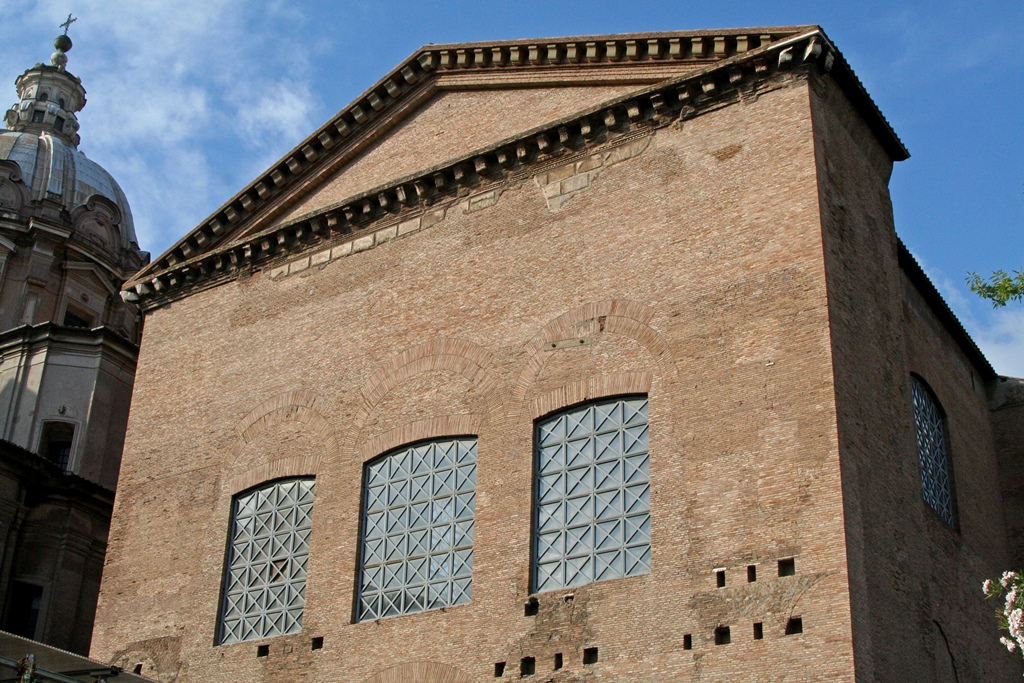
Curia Julia

Curia Interior

Relief Panel
Connie, Relief Panel and Floor
The Arch of Septimius Severus is also found near the Curia. It was dedicated in 203 A.D.
to commemorate victories in campaigns against the Parthians (who lived in the area of what is
now Iran and Iraq) by the emperor Septimius Severus. Its structure, with two side arches,
has been much copied, as in the design of the Arch of Constantine, near the Colosseum.

Arch of Septimius Severus

Column, Rostrum, Arch of Septimius Severus

Arch of Septimius Severus
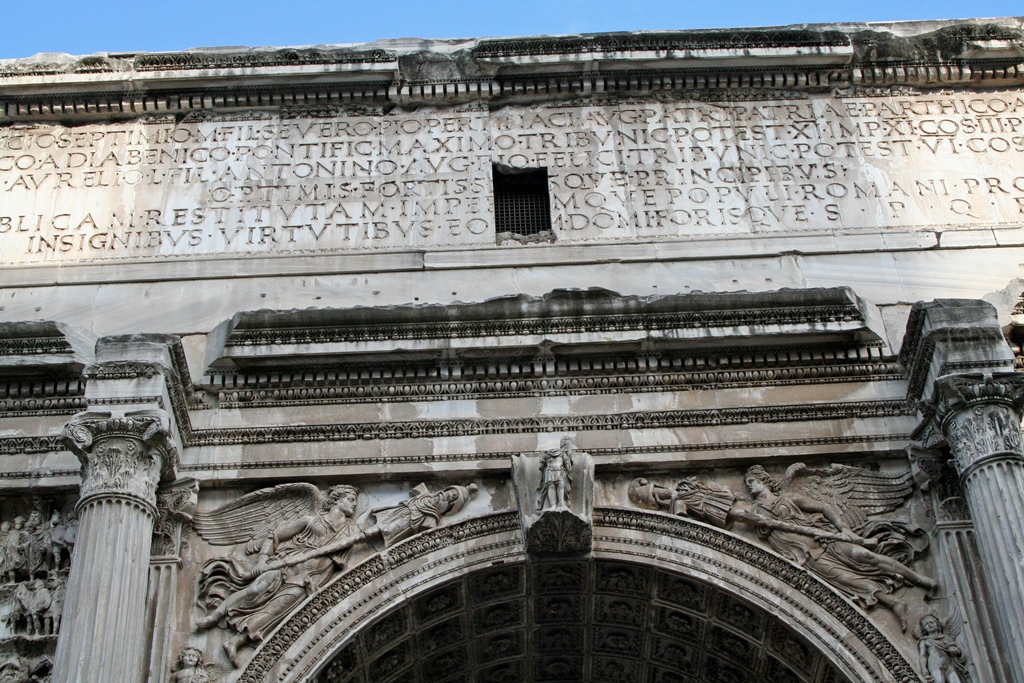
Inscription, Arch of Septimius Severus
Inscription and Arch Details
South of the Arch are the eight remaining columns from the portico of the Temple of Saturn,
the Roman god of agriculture. The well-preserved inscription at the top is Latin for "The
Senate and People of Rome restored what fire had consumed", reflecting the fact that this
was part of a 283 A.D. rebuild of an earlier structure which had been destroyed. This
structure had been used to house part of the Treasury, plus the State Archives. Next to
the Temple of Saturn are the remaining three columns of the Temple of Vespasian and Titus,
which was completed by Titus's brother Domitian following Titus's death in 81 A.D.
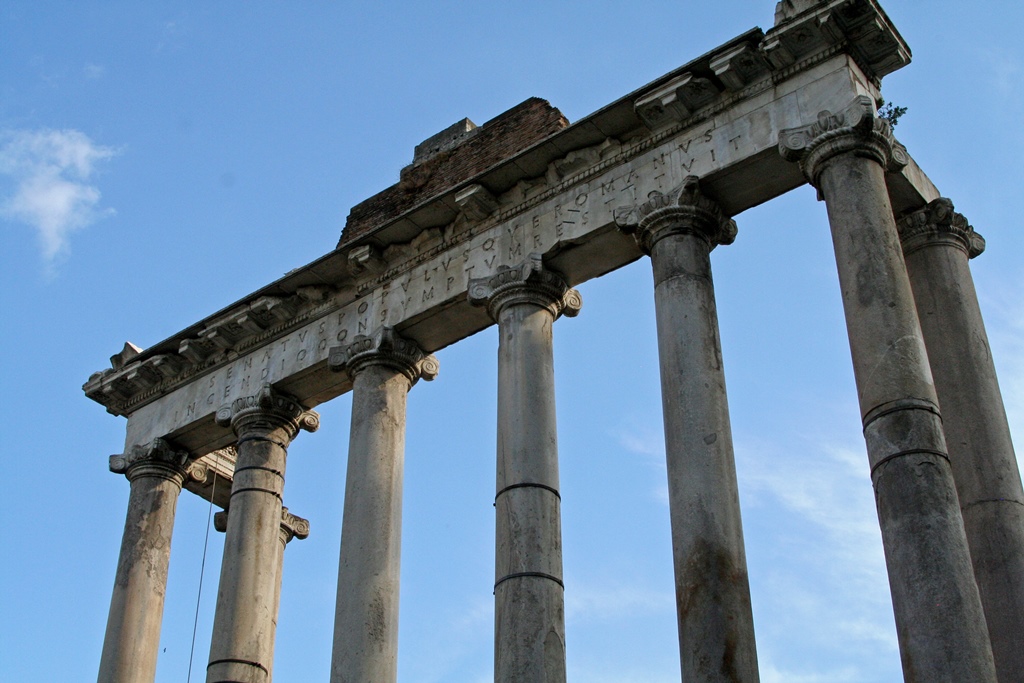
Temple of Saturn

Temple of Saturn, Temple of Vespasian

Connie and Ruins
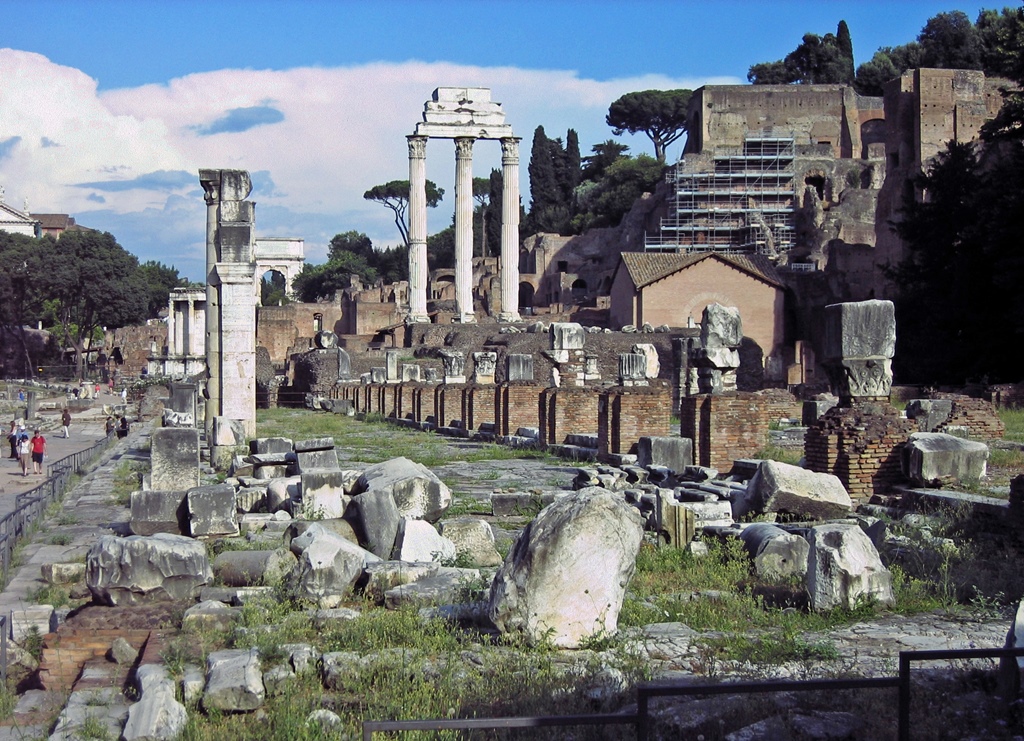
Southwestern Forum
We exited the Forum at the west end and crossed the Via dei Fori Imperiali to see the
Forum of Trajan, which was built by the emperor Trajan and his chief architect, Apollodorus
of Damascus, being completed in 112 A.D. The large semicircular structure of Trajan's Markets
remains; this was an early shopping mall. Several short columns remain in front of the
Markets - these were once part of the Basilica Ulpia.
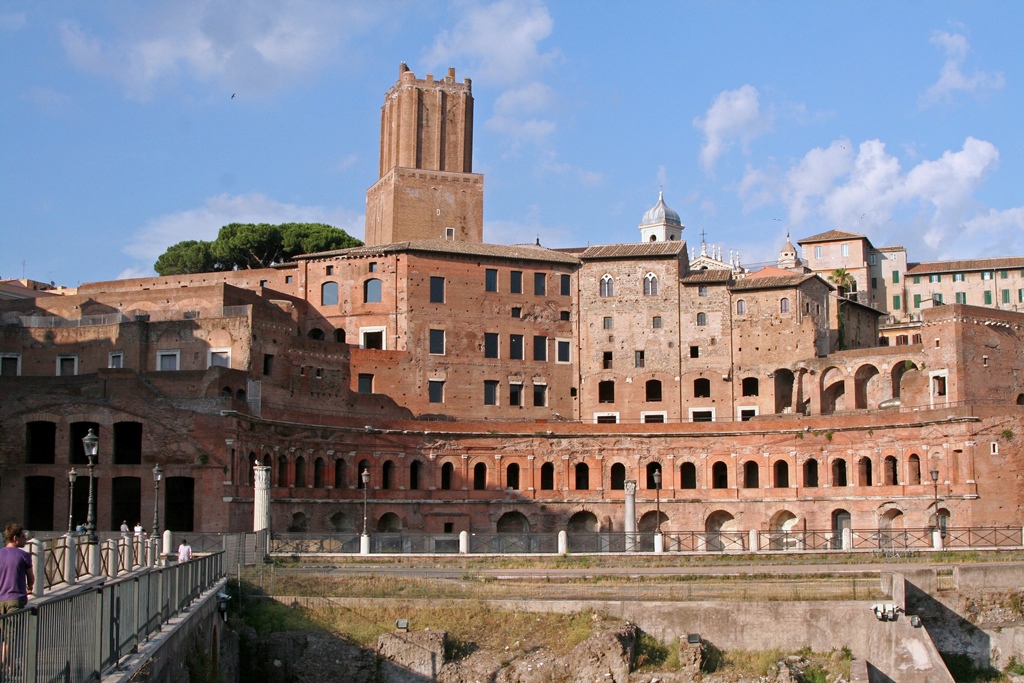
Trajan's Markets
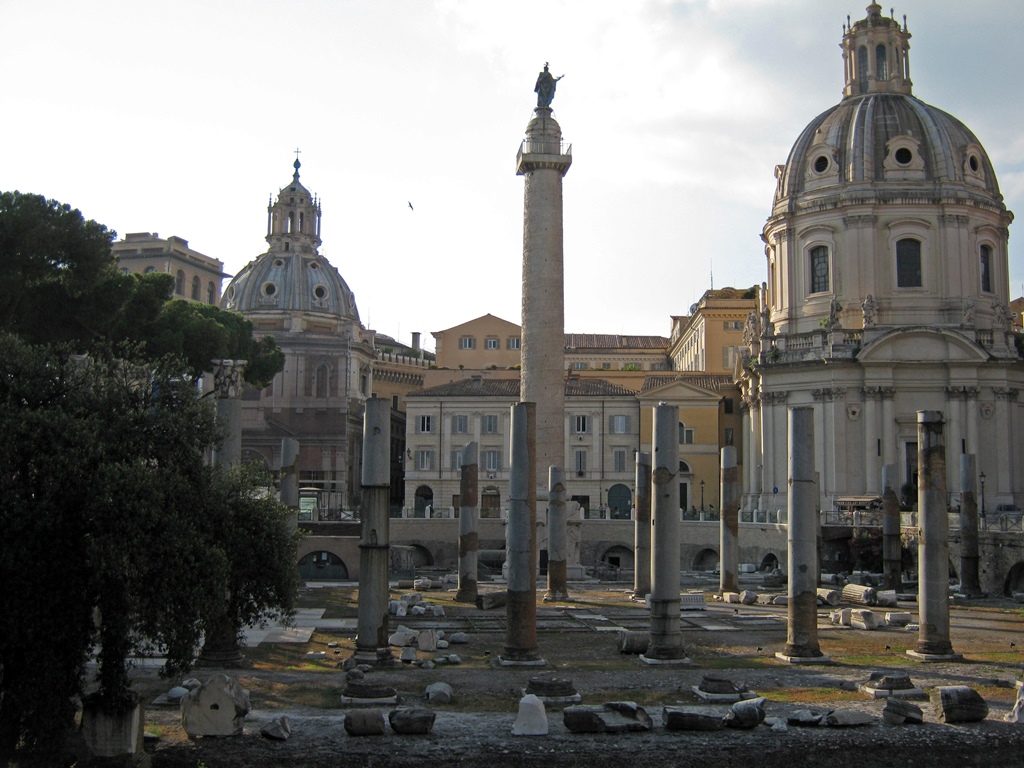
Columns, Forum of Trajan
Back across the Via dei Fori Imperiali, we couldn't miss the immense (and much newer) Victor
Emmanuel Monument, dedicated to Victor Emmanuel II, the first king of a modern, reunified Italy.
The monument was dedicated in 1911, and modern Romans are somewhat embarrassed by it, finding it
absurdly grandiose (it has received a number of disparaging nicknames, such as "The Typewriter"
and "The Wedding Cake").
Victor Emmanuel Monument
At this point we'd had enough for one day, so we caught a bus in the Piazza Venezia, in
front of the Victor Emmanuel Monument, and returned to our apartment. We had elaborate
plans for the next day as well, and a certain amount of rest seemed to be called for.















































